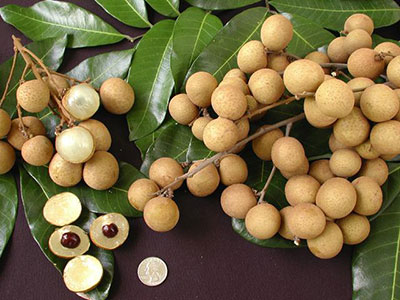Scientific Name: Dimocarpus longan Lour.
Common Names: lungan, dragon eye, longana, leng keng
Origin: southern China, Sri Lanka, Indochinese peninsula, southwest India, Mayanmar (Burma)
Climate: Longan grows in a tropical climate and subtropical areas with a cool and freeze-free period. Because longan is indigenous to lowland and middle elevations of southeast Asia, it can grow at elevations from sea level to 1500 feet. Longan likes warm temperatures (70–85°F) during spring and high summer temperatures (80–95°F) with a high level of soil moisture. Excessive rain reduces pollination, fruit set, and flower drop.
Varieties: 30 to 40 varieties of longan grow commercially worldwide. 99% of longan trees grown in Florida are ‘Kohala’ cultivar. However, several new cultivars such as ‘Edau’ (‘Daw’), ‘Chompoo’, ‘Haew’, ‘Diamond River’, and ‘Biew Kiew’ are introduced in Florida, but all are under further evaluation.

Propagation: Trees grown from seed do not have all characteristics of parents, and they are slow to bear (several years) with low-quality fruits. For these reasons, vegetative methods such as air layering, cuttings, and grafting are more common in Florida. For air layering, April through August is the best time. Side veneer and cleft grafting are common grafting methods. Vegetatively propagated trees (not grown from seeds) may produce fruits 2 to 3 years after planting while seedling trees will not produce fruit after 6 years.
Fertilizer: For young trees, ¼ lb fertilizer such as 6-6-6 (% nitrogen-% phosphate-% potassium) with minor elements with 20 to 30% of the nitrogen from organic sources is recommended one month after planting. Applying fertilizer may be repeated every 6 to 8 weeks for the first year. The amount of fertilizer will gradually increase to 0.5, 0.75, 1.0 lb as the tree grows.
Irrigation: Since longan tree likes wet soil, it should be irrigated regularly for the optimum yield. Bearing trees need to be irrigated regularly from flowering through harvest.
Pest and disease: Although longan trees have a few insect problems in Florida, some of them such as lychee webworm and several scale insects may cause severe damage to the trees. Adult Sri Lankan weevil (Myllocerus undecimpustulatus undatus), a citrus blue-green weevil (Pachnaeus litus), little leaf notcher (Artipus floridanus) and diaprepes weevil (Diaprepes abbreviatus) are some other common insects of longan trees.
No major disease has been reported on longan trees in Florida. Red alga, however, may damage shoots during warm and humid weather. The common symptoms are dark gray to reddish-rust-colored patches or spots on bark and/or leaves. If it is not controlled, it may lead to leaf drop and stem dieback.
Pest and disease management: Please contact your local UF/IFAS Extension office for current control recommendations.
 0
0
